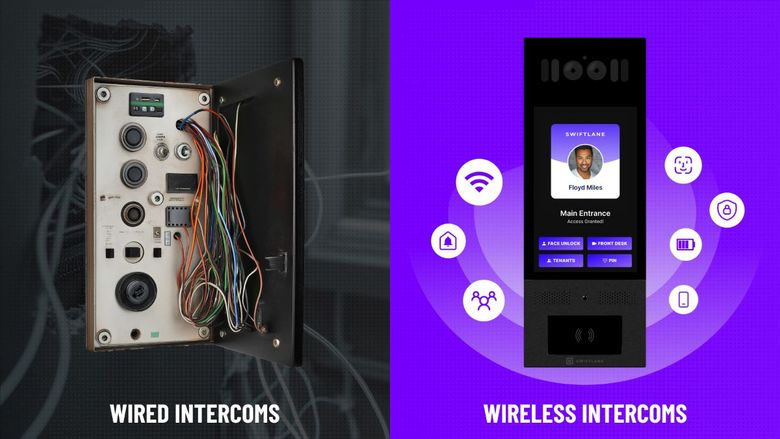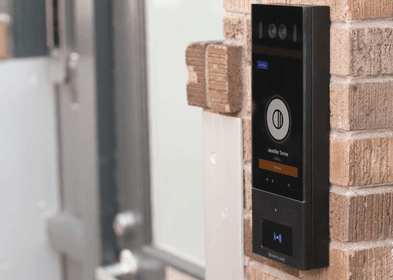A wired intercom system is a reliable and effective solution for seamless communication in residential, commercial, and industrial settings. By connecting multiple locations through a network of physical cables, these systems offer exceptional audio clarity, durability, and security, making them ideal for environments where consistent performance is essential.
This guide provides a comprehensive overview of wired intercom systems, including their components, installation requirements, and practical applications, helping you select and implement the best solution for your specific needs.
Learn more about best intercom systems in 2025 for every type (wireless, touchscreen, IP and more).
Table of Contents
- What Is a Wired Intercom System?
- Benefits of Wired Intercom Systems
- Wired vs. Wireless Intercom Systems: Key Differences
- Understanding 2-wire vs. 4-wire intercom systems
- Top Wired Intercom Manufacturers
- Swiftlane: An Alternative to Wired Intercoms
- Installation Tips and Considerations for Wired Intercom Systems
What is a Wired Intercom System?
A wired intercom system is a communication device that uses physical wiring, such as traditional copper wiring, cables, or fiber optics, to connect intercom stations within a building or across multiple locations. These systems are typically installed during construction or as part of a retrofit project because the cabling goes behind the walls.
Wired intercoms facilitate communication between a main station, such as a front door intercom, and substation units throughout the building. They help monitor entrance spaces and provide access control. In commercial settings, they can also be used as public address systems.
How Wired Door Entry Systems Work
Wired intercoms consist of master stations, such as the main door intercom unit, and sub-stations connected through dedicated wiring. The system transmits audio (and sometimes video) signals between these stations. When a user speaks into one station, the signal travels through the wiring to the receiving station, enabling seamless communication.
Note: When describing intercom systems, the terms “wired” and “wireless” typically refer to the communications connection between the main intercom unit and its substations—not the power source. Most intercom systems, including wireless ones, still require the main intercom station to be wired to a power source and are usually wired to the door release mechanism, too. A fully wireless intercom system, powered entirely by batteries, is generally limited in application and is suitable primarily for single residences or small commercial spaces like retail shops.
Benefits of Wired Intercom Systems
Reliability – Wired systems are less affected by interference from wireless devices or environmental factors, ensuring consistent performance.
Durability – The components of a wired system are often built to last, providing years or even decades of trouble-free operation with minimal maintenance.
Enhanced Security – Wired intercoms are less susceptible to hacking or signal interception, making them a more secure choice for residential and commercial properties.
High-Quality Audio and Video – Some wired systems typically deliver superior audio and video quality due to their stable connections and absence of latency. However, read below on the differences between 2-wire and 4-wire systems and half-duplex and full-duplex communications.
Customization – They can be integrated with other security systems and are often tailored to the specific needs of the property.
Full Ownership – With a wired system, the building usually owns all the infrastructure that connects the building units. Therefore, there is no monthly service fee. With wireless systems, there are usually monthly services fees for internet connectivity, a telephone line, and/or access to an online management portal.
Is a Wired Intercom System Right for Your Property
A wired intercom system may be ideal for:
- New Construction or Gut Renovations: It’s easier and more cost-effective to install wiring during the construction phase.
- Permanent Properties: For homes or businesses where future relocation is unlikely, the investment in a wired system pays off in reliability and longevity.
- High-Security Needs: Properties requiring advanced security features like encrypted communication and integrated surveillance.
- Noise-Prone Areas: Wired systems perform better in environments with potential interference, such as industrial zones or densely populated areas.
- Commercial and Warehouse Spaces: Wired intercoms can work for both door entry and as a public announcement/paging system in large facilities like a big box store or warehouse. Microphone or PA units are wired to multiple speakers throughout the facility.
Wired vs. Wireless Intercom Systems: Key Differences
While wired door intercom systems are suited to the above cases, wireless systems have become more popular in recent years. The main limitation of wired systems is that answering a call or opening the door requires someone to be physically present at one of the wired substations in the building. If you’re not at home or in the office, the door remains unanswered. With the increasing number of deliveries, service workers, and contractors visiting residential and commercial spaces, this can be a significant inconvenience.
Wireless intercoms with internet protocol (IP) technology address this issue by enabling tenants to answer the door remotely from their mobile devices, no matter where they are. We highlight some additional key differences between the two communication modes.
Choosing Between Wired and Wireless
In recent years, wireless intercoms have become more common than wired systems. This reflects some of the downsides of wired systems.
- High Upfront Cost: Wired systems are usually significantly more expensive to install, especially in an existing building.
- No Mobile Access Control: Wired systems have fixed substations located in each tenant unit, and the tenant must usually be present to answer a call. Most wireless systems connect to the Internet, so users can respond to calls from anywhere they carry an Internet-connected device, even if they aren’t present in the building.
- No Cloud-Based Management: Wired systems must typically be maintained and managed on-premises, often by a security services technician. Wireless systems typically have user-friendly cloud-based management platforms, which means you can log into the system and add or remove users from anywhere, including a central management office that oversees several buildings. This saves on operating costs.
As an alternative to wired systems, choose wireless systems if your building needs flexibility, ease of installation, a budget-friendly solution, and if you want tenants to be able to answer the door remotely – a feature most tenants love.
Understanding 2-wire vs. 4-wire intercom systems
As you research potential wired intercoms, you’ll discover they connect using either a 2-wire or 4-wire set-up. The key difference between 2-wire and 4-wire intercom systems lies in how they handle power, communication, and signal transmission, affecting their functionality and applications.
A 2-wire system uses the same pair of wires for power and communication, enabling half-duplex communication—only one party can talk at a time. While cost-effective and simple to install, it’s prone to signal interference and lacks support for features like video or full-duplex conversations. These systems are best suited for basic setups, such as single-family homes or standalone intercoms.
In contrast, a 4-wire system separates transmitting and receiving signals, enabling full-duplex communication and superior audio quality. It supports advanced features like video, making it ideal for larger or modern setups such as multi-unit apartments or smart homes. However, 4-wire systems are more complex and costly to install, requiring additional materials and labor.
Key Differences at a Glance
- 2-Wire Systems:
- Use two wires for all communication and power.
- Operate in half-duplex mode, where only one party speaks at a time.
- Easier and cheaper to install but limited in performance and features.
- 4-Wire Systems:
- Use four wires, with separate pairs for transmitting and receiving.
- Enable full-duplex communication for simultaneous talking and listening.
- Offer better performance and advanced features but at higher cost and complexity.
Top Wired Intercom Manufacturers
Several companies manufacture reliable wired intercom systems, typically for high-security or commercial use. Some well-known brands that offer wired intercoms include:
Aiphone – Good for Commercial Buildings
Aiphone is a leading manufacturer of both wired and wireless intercoms and offers a range of systems suitable for residential, commercial, and industrial applications.
The Aiphone YAZ-90-3W is a handset loop-wired intercom system supporting up to 90 stations, suitable for commercial buildings.
Aiphone TC-M is an internal telephone-type intercom system that’s expandable up to 60 stations, ideal for environments that have numerous zones, including office buildings, large warehouses, manufacturing facilities, and educational or healthcare buildings.
AMOCAM – Good For Smaller Buildings
Known for producing a variety of intercom systems, including wired options, AMOCAM specializes in video intercoms for commercial and residential use.
The company’s V70C-530-4 Video Intercom System offers a set of four wired video door substations each with a 7-inch monitor. The intercom unit with an outdoor camera supports remote unlock and a dual-way intercom designed for home video surveillance. The front door intercom can be wired to four residences or commercial units. It comes with a built-in RFID key fob reader.
BTicino – Good for Mid-Sized Buildings
Known for its premium wired intercom systems, BTicino offers integrated solutions for residential, commercial, and multi-tenant buildings. Their Linea 5000 intercom is a sleek and modern-looking touchscreen video intercom, while the Linea 300 vandal-resistant lineup consists of more traditional and robust push-button units made of stainless steel for higher durability.
All of their intercom lines offer individual residential or commercial unit modules known as Classe 100, which are available as wired audio-only telephone-style units or video and audio video monitor units. The company also offers a wireless WiFi-based version of units for those seeking a wireless solution.
Comelit – Good for Sleek Design
Comelit is an Italian company specializing in security and communication systems, including intercoms. They are renowned for their sleek, modern designs and advanced technology, offering both audio and video intercom solutions for residential, commercial, and industrial applications. Comelit systems often feature user-friendly interfaces, seamless integration with home automation, and robust durability, making them a popular choice for stylish, high-performance intercom installations.
Comelit makes a line of People Monitor unit door answer stations that connect by cable to a main power supply and the door entrance panel intercom. Communications and electricity are delivered over the same cable for a less complicated installation.
Hikvision: Good For Building Retrofits
Hikvision is a global leader in security technology, offering advanced intercom systems for residential and commercial use. Their solutions feature high-definition video, touch-screen interfaces, remote mobile access, and seamless integration with security ecosystems. Designed for modern environments, Hikvision intercoms provide reliable, user-friendly communication and enhanced security.
Hikvision’s 2-wire intercom system can be a good choice if you are looking to retrofit a building with an existing wired system. Its intercom and substations can be linked to the building’s existing wiring, giving older intercoms, even audio-only systems, a sleek upgrade that includes video intercom capabilities.
Swiftlane: An Alternative to Wired Intercoms
Swiftlane manufactures intercom systems using a modern alternative to traditional wiring. We use Internet Protocol (IP) to wirelessly connect the front door intercom over the internet to individual residents’ or commercial tenants’ mobile devices. That way, building tenants can respond to calls from wherever they are, even when they’re not in the building.
Powered with simple low-voltage wiring for easier installation, Swiftlane Video Intercom features:
- High-quality two-way video and audio delivered over an encrypted internet connection.
- Remote management using our cloud-based management platform to quickly add and remove users from your central management office.
- A sleek design with full-color touchscreen to leave a lasting impression.
- Entry using PIN and QR codes, key fobs and ID badges, or mobile devices
- Facial recognition access control for tenant convenience and building security.
- Huge national network of professional installers and 24/7 support.
Installation Tips and Considerations for Wired Intercom Systems
Here is our general checklist for preparing for a wired intercom installation. However, your system manufacturer may inform you of additional recommended steps.
- Plan Early: If installing in a new build, incorporate wiring plans into the construction phase to minimize costs and disruptions.
- Choose Strategic Locations: With a wired system, each tenant has to have its own intercom unit to connect to the main intercom. Identify the best locations for intercom stations to maximize coverage and convenience, such as near entry points, kitchens, or living rooms.
- Hire Professionals: A qualified installer ensures compliance with electrical codes, proper wiring, and seamless integration with other systems. Professionals are almost always needed for wired intercom systems. They are easiest to install during construction and renovation when cable conduits are installed behind the walls.
- Test Before Finalizing: Conduct a thorough system test before finalizing the installation to ensure all stations are functional and the audio/video quality meets expectations.
- Use High-Quality Materials: Invest in durable cables and components to minimize maintenance needs and ensure long-term reliability.
Challenges of Installing a Wired Door Entry System
- Retrofitting Older Buildings: Installing wired systems in existing structures may require cutting through walls or floors, increasing labor and costs.
- Complex Wiring Layouts: Large or multi-story properties may need extensive wiring, which can complicate installation and increase costs.
- Upfront Costs: Wired systems generally have higher initial costs for materials and labor than wireless alternatives. However, since the building owns all the infrastructure, you may avoid monthly service charges billed by many wireless intercom providers.
- Integration Challenges: Compatibility with existing systems (e.g., security cameras doorbells) can be a concern if not addressed during planning. A security services company can usually answer questions about integration of the intercom system with other building systems, including fire alarms and surveillance cameras.
- Disruptions: Installation can be invasive and may temporarily disrupt daily activities.
Want to learn more about Swiftlane and our options for wireless building intercoms? Schedule a demonstration with us or get a quote.
Get a Quote!
Reach out for live product demonstrations and pricing.










